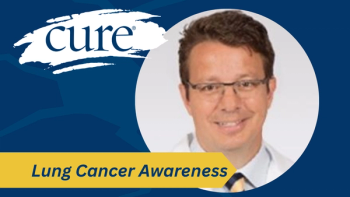
Oncologist Debunks Clinical Trial Myths
Before enrolling in a clinical trial for metastatic breast cancer, it’s important to know which are best suited for each individual, an expert said.
Patients with metastatic breast cancer should understand what clinical trials entail, when to enroll in them and what to expect, an expert said during the CURE® Educated Patient® Metastatic Breast Cancer Summit.
Because the role of clinical trials is often not explained well to patients, Dr. Rebecca Shatsky said, it’s necessary to debunk some of the myths caused by misinformation first.
Shatsky is a medical oncologist and associate professor of medicine at the University of California San Diego Moores Cancer Center.
A common myth, she noted, is the belief that patients who enroll in clinical trials could be randomly assigned to receive only placebo (inactive drug).
“No, that’s a myth,” she explained. “If you have active breast cancer, you will never be randomized to just a placebo because that is unethical and illegal. So, if you are on a randomized clinical trial, you will always get either the study drug combination or the standard of care, which has to be the ‘gold standard’ of therapy for what your specific breast cancer subtype is and for where you are in your therapy journey.”
Another common myth about clinical trials included only being available for patients who no longer have treatment options.
Shatsky clarified that clinical trials “actually are looking for patients earlier on in their journey, and I think that the community oncologists probably need to be a little bit more educated on this process, as well, because often, they’re referring patients a little bit too late for clinical trials.”
Once patients have undergone more than four lines of therapies, trials may not allow them to enroll, she said.
“The longer that [patients] have had metastatic breast cancer, the more resistant to treatment [the cancer] can become as the cancer mutates,” she said. “The best time to go looking for clinical trials is when [patients have] had maybe no treatment for metastatic breast cancer or somewhere between second and fourth line of therapy.”
Breast cancer subtype should also be considered in the clinical trial decision-making process, Shatsky said.
Metastatic Triple-Negative Breast Cancer
For metastatic triple-negative breast cancer, the best time to enroll in a trial is anytime, she emphasized.
“We have lots of clinical trials for first-line metastatic disease and we’re constantly improving and changing the standard of care for triple-negative breast cancer,” Shatsky said. “So, from first line and beyond is always a good time to consider clinical trials for triple-negative breast cancer.
“Unfortunately, our outcomes in this disease, specifically, are not good enough by any means,” she explained. “The survival is not anywhere near [where] it is for HER2-positive and estrogen [receptor]-positive, HER2-negative breast cancer, so clinical trials are essential for patients to seek out in this specific disease population.”
Estrogen-Positive or HER2-Negative Breast Cancer
For patients with estrogen receptor (ER)-positive or HER2-negative metastatic breast cancer, Shatsky noted that it’s rare to find trials for first-line treatment because first-line therapy typically works well. Nevertheless, she explained that if patients can enroll in a trial for first-line treatment, it’s likely compelling.
“If the drug company is putting [a treatment] out in the first-line setting, they must be pretty convinced that their therapy is good enough — that it could rival the current standard of care, so that is an interesting option if [patients] can find one,” she said.
Enrolling in a trial for second-line treatment and beyond is a “fantastic idea,” Shatsky said. Many new treatments are being explored that may be even more improved than current second-line treatment options, she said.
Of note, Shatsky explained that for patients whose ER-positive or HER2-negative disease has become hormone-refractory — meaning it stopped responding to anti-estrogen therapies — then it’s essential to look for trials because of resistance to available treatments.
HER2-Positive Metastatic Breast Cancer
Anytime is also a good time to enroll in a clinical trial for patients with HER2-positive metastatic breast cancer, Shatsky said. Notably, there is a new novel brain-active drug for patients who experience active brain metastases, which is a great thing to look for, she said.
However, the most optimal time to enroll in a clinical trial is after the first line of treatment. Shatsky explained that first-line treatments already work well, so trials in the second-line or beyond are better.
The Meaning of Clinical Trial Phases
Phase 1 trials include approximately 15 patients total, but phase 1b trials expand upon phase 1 and can be larger (usually up to 100 patients), Shatsky said. During this phase, the safety and efficacy of the novel drugs are evaluated in patients. This helps determine how high a dose patients can tolerate without serious side effects.
Phase 2 trials evaluate the efficacy of the novel treatment to see what benefits patients may receive, Shatsky said. Approximately 25 to 300 patients are included in phase 2 trials, which last approximately two years.
In phase 3 trials, patients are placed in different treatment groups to compare the novel treatment with an available type of treatment. This is to see how well the novel treatment works when compared with an available treatment, she mentioned, and whether patients experience fewer side effects when treated with the novel treatment. Phase 3 trials can last for several years and include 100 to 3,000 patients, according to Shatsky.
Phase 4 studies identify the long-term effects of the treatment to get “a full picture” of safety, efficacy, benefits or optimal use.
“Patients aren’t necessarily enrolled in a phase 4 [trial], it’s more of a term we use to gather long-term safety data,” she said.
How to Know Which Clinical Trial to Enroll in
For patients with early disease, phase 2 and 3 trials are good ones to enroll in because the novel treatment is known to be effective, Shatsky said. However, she also explained that phase 3 trials typically include randomization, in which patients may receive either the novel treatment or standard of care.
“Unfortunately, the drug development process from start to finish can take up to 14 years before something is [Food and Drug Administration (FDA)]-approved,” she explained. “Getting in on that phase 3 clinical trial setting, you may have the opportunity to have treatment with something [potentially] better than the standard of care and has [fewer] side effects.”
Enrolling in a phase 1 trial may be best for patients who have received more than four lines of treatment, Shatsky advised, and have exhausted the standard treatments proven beneficial to their disease type.
Of note, she also mentioned that phase 1 trials are best for patients who are not interested in receiving standard-of-care treatments and want to try a novel treatment. Some “out-of-the-box” treatments that are being evaluated in phase 1 and 2 trials include immunotherapy for breast cancer, Shatsky said.
Overall, to enroll in a trial, Shatsky emphasized two things: the trial has to have room and patients must have experienced disease progression or could no longer tolerate their last therapy.
“They don’t let [patients] stop a therapy that [they’re] on that is actively working because no one wants to stop something that is working,” she said. “We don’t know that if we stop it and it’s working, that we can go back to it in the future and it will work [again],” she said.
Editor's note: This program was made possible with support from Daiichi Sankyo Inc.
For more news on cancer updates, research and education, don’t forget to





